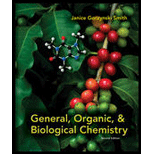
Concept explainers
(a)
Interpretation:
The number of grams of sodium hydrogen formed from
(a)
Answer to Problem 5.78AP
The number of grams of sodium hydrogen formed from
Explanation of Solution
Given,
Moles of
The balanced chemical equation is,
The number of moles of sodium hydroxide formed from
The number of moles of sodium hydroxide formed from
Moles can be converted into grams using the conversion factor:
The number of grams of sodium hydroxide formed from
The number of grams of sodium hydrogen formed from
(b)
Interpretation:
The number of grams of hydrogen formed from
(b)
Answer to Problem 5.78AP
The number of grams of hydrogen formed from
Explanation of Solution
Given,
Moles of
The balanced chemical equation is,
The number of moles of hydrogen formed from
The number of moles of hydrogen formed from
Moles can be converted into grams using the conversion factor:
The number of grams of hydrogen formed from
The number of grams of hydrogen formed from
(c)
Interpretation:
The number of grams of water that is required to react with
(c)
Answer to Problem 5.78AP
The number of grams of water that is required to react with
Explanation of Solution
Given,
Moles of
The balanced chemical equation is,
The number of moles of water that is required to react with
The number of moles of water that is required to react with
Moles can be converted into grams using the conversion factor:
The number of grams of water that is required to react with
The number of grams of water that is required to react with
Want to see more full solutions like this?
Chapter 5 Solutions
General, Organic, & Biological Chemistry
- Citric acid (C6H8O7) is made by fermentation of sugarssuch as sucrose (C12H22O11) in air. Oxygen is consumedand water generated as a by-product. (a) Write a balanced equation for the overall reaction thatoccurs in the manufacture of citric acid from sucrose. (b) What mass of citric acid is made from 15.0 kg sucrose?arrow_forwardConsider the following reaction.Na2S2O3 (aq) + Cl2 (g) + H2O (l) → NaHSO4 (aq) + HCl (aq)a) How many moles of Na2S2O3 are needed to completely react with 0.12 moles of Cl2?b) How many moles of HCl can be produced from 0.12 moles of Cl2?c) How many moles of H2O are needed to completely react with 0.36 moles of Cl2?d) How many moles of Cl2 would have to react to produce 0.24 moles of HCl?arrow_forwardConsider the combustion of an alcohol:C3H8O(l) + O2(g) → CO2(g) + H2O(g)a. Balance the chemical equationb. How many moles of CO2 can be formed from 3.68moles of the alcohol?c. How many moles of O2 are required to react with 0.931moles of the alcohol?d. What is the maximum number of moles of CO2 that can be formed from a mixture of 1.81moles of the alcohol and 7.43moles of O2arrow_forward
- ---CH3NH2(g)+---02(g)= CO2(g)+----H2O(g)+----N2(g) Consider the oxidation of methylamine shown in the image above. a.When properly balanced the coefficient infront of O2= ? b. If you want to combust 45.0 g of CH3NH2, how many grams of O2 do you need? c. How many grams of N2 gas can be formed from this oxidation?arrow_forwardPart A: How many moles of H2OH2O are produced when 0.170 mol of octane is burned? Part B: How many moles of CO2 are produced when 6.39 mol of oxygen reacts with octane?arrow_forwardUse the balanced equation, N 2 + O 2------>2 NO, to answer the following questions. a. How many grams of NO are formed from 10.0 g of N 2? b. How many grams of NO are formed from 10.0 g of O 2? c. How many grams of O 2 are needed to react completely with 10.0 g of N 2?arrow_forward
- How many moles of Al2O3 can be formed from 19.2 g of O2? How many grams of Al2O3 can be formed from 19.2 g of O2?arrow_forwardIn a closed reaction container of 10.0 grams of carbon monoxide and 10.0 grams of oxygen were combined to form CO2. 1. How many moles of CO2 could be produced if you were to use all of CO? 2. How many moles of CO2 could be produced if you were to use all of O2? 3. Which reactant is the limiting reactant, CO or CO2? Why? 4. How many moles of the non-limiting reactant are used for this reaction? How many moles of it are left over? How many grams of the non-limiting reactant are left over? 5. How many grams of CO2 would be produced theoretically? 6. What is the percent yield if 9.8 g of CO2 is actually produced?arrow_forwardThe balanced equation for the decomposition of ammonium nitrate is 2NH4NO3(s)→2N2(g) + O2(g) + 4H2O(g) (b) How many moles of each product would form if 1.00 mol of NH4NO3 reacts? (c) How many moles of each product would form if 7.28 mol of NH4NO3 react?arrow_forward
- C6H8 + O2 ------à CO2 + H2O Balance the equation How many moles of O2 are needed to form 60 moles of CO2 ? How many grams of C6H8 are needed to from 72grams of H2O ?arrow_forwardAnswer the following questions about diethyl ether (C4H10O, molar mass of 74.1 g/mol), the first widely used general anesthetic. Diethyl ether can be prepared from ethanol according to the following balanced equation. a. How many moles of diethyl ether are formed from 2 mol of ethanol? mol diethyl ether b. How many moles of water are formed from 6 mol of ethanol? mol waterarrow_forward2.) Using the following equation for the combustion of octane, calculate the amount ofenergy released from 100.0 g of octane.2 C8H18 + 25 O2 → 16 CO2 + 18 H2O ΔH°rxn = -11018 kJarrow_forward
 Chemistry by OpenStax (2015-05-04)ChemistryISBN:9781938168390Author:Klaus Theopold, Richard H Langley, Paul Flowers, William R. Robinson, Mark BlaserPublisher:OpenStax
Chemistry by OpenStax (2015-05-04)ChemistryISBN:9781938168390Author:Klaus Theopold, Richard H Langley, Paul Flowers, William R. Robinson, Mark BlaserPublisher:OpenStax Principles of Modern ChemistryChemistryISBN:9781305079113Author:David W. Oxtoby, H. Pat Gillis, Laurie J. ButlerPublisher:Cengage Learning
Principles of Modern ChemistryChemistryISBN:9781305079113Author:David W. Oxtoby, H. Pat Gillis, Laurie J. ButlerPublisher:Cengage Learning

